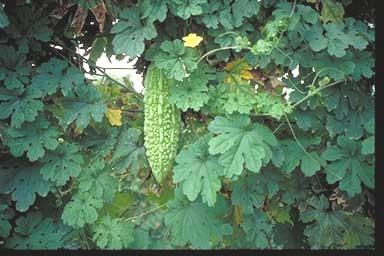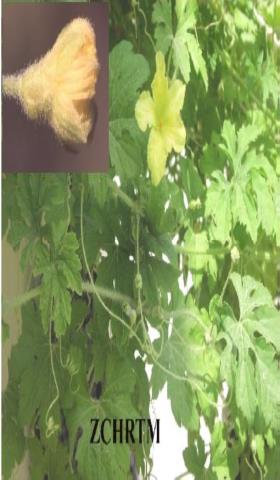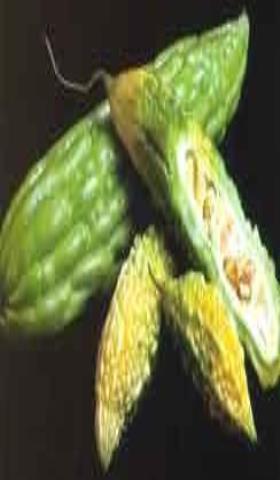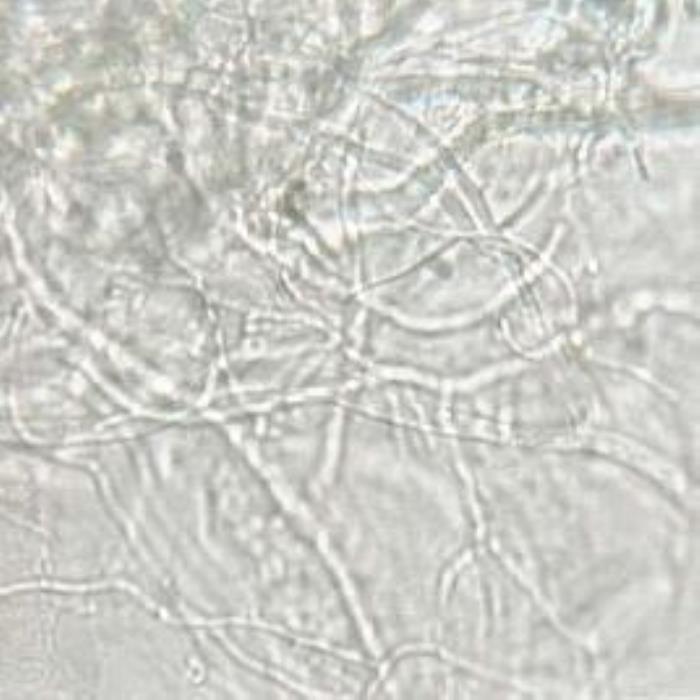
Momordica charantia / خیار كیرالا
Khyar Karilla
Bitter gourd, Karilla fruit, Balsam pear, Karolla,Cearasee
Cucurbitaceae

Aerial part

Flowers

Fruits
Ethnobotanical Characteristics
Description
Herbaceous climber, much branched angled stems, tendrils simple,. Leaves palmately 5-9 lobed, cordate at base, 2-4.5 in. long, the lobes more or less sinuate. Flowers yellow, on a long slender peduncle with a reniform bract at the base or towards the middle. Fruit orange when ripe, about 1½ in long or more, ovoid fusiform, with longitudinal tubercled lines, muricate when young, with a decurved beak; seeds many enclosed in scarlet pulp with shinning sculptured surface.
Habitat & Distribution
Widespread in the tropical and subtropical regions of the world. Native to India Bangladesh and cultivated in many countries.
Part(s) Used
Fruits, seeds, leaves and roots.
Traditional & Medicinal Uses
M. charantia is an important food plant in some parts of the tropics and is traditionally used in many countries e.g. South America, Caribbean, Australia, Africa, Asia especially in India and China. In general the plant is used as a tonic, stimulant, laxative, anthelmintic, antidiabetic, abortifacient, anti-malaria, contraceptive, carminative, anti-inflammatory, anticancer, digestive, febrifuge, vulnerary and used for ulcers, tumors, leprosy and snakebite. Roots are bitter, acrid, astringent and ophthalmic, used for eye problems and colopoptosis. Leaves are bitter, emetic, purgative, antipyretic and anthelminthic, used for skin diseases, diabetes, constipation, helminthiasis, fever, ulcers, flatulence, wounds, anorexia, colic, hemorrhoids, rheumatalgia, gout, asthma, debility, dysmenorrhea, hepatomegaly, inflammation, impurity of breast milk, jaundice, leprosy and topically for lambago, ulceration and bone fractures. Fruits are bitter and acrid, used as antidiabetic, anthelminthic, purgative, tonic, stimulant, depurative, appetizing, carminative, digestive, anti-inflammatory, emmengagogue, febrifuge, vulnerary, thermogenic, stomachic. In Turkish folk medicine mature fruits are internally for the treatment of peptic ulcers and externally of the rapid healing of wounds and for tumors. In culinary the young fruits are added to curies or eaten raw, boiled or fried after soaking in salt to remove bitterness. Seeds are used in the treatment of ulcers, pharyngodynia and liver and spleen problems, seed oil is used to heal wounds.
Pharmacognosy and Phytochemistry
Parts Studied
Unripe fruits
Microscopical Description
Unripe fruit: The outer rind has prominent interrupted irregular large ridges and tapering outgrowths which are extensions of the pericarp. The epicarp is very thick and it is covered with a thick striated cuticle. The epidermis consists of a layer of relatively small parenchyma rich in chlorophyll. The stomata are anomocytic and are rich in small sized starch granules. The epidermis also bears two-celled uniseriate covering trichomes as well as glandular trichomes commonly found on the outgrowth. The sub-epidermal tissues consist of several layers of round to oval parenchyma enclosing chloroplasts and colored matter. The juicy mucilaginous mesocarp consists of large oblong parenchyma almost devoid of chlorophyll but occasionally contain colored matter. These are underlain by a few layers of almost colorless small-sized parenchyma followed by several layers of collenchyma traversed by non-lignified branching vascular strands some of which form loop structures. Few oblong, thick walled, unlignified sclerenchyma are also found. Inner mesocarp consists of polygonal parenchyma cells and those at the central part are torn thus forming a central cavity. Very long intricate fibers are densely distributed within the cells. The fruit endocarp is formed of an orange to crimson red membrane of easily separable oval parenchyma that cover the seeds (DPS, ZCHRTM unpublished results).

a) Epicarp of fruit

b) Colloenchyma of mesocarp

c) Intricate fibers
- (a). Surface view of the epicarp of the fruit ridge showing its polygonal cells, the covering striated cuticle, a short two-celled covering trichome and oval starch-rich stomata; shown also is part of the underlying outermost layer of the mesocarp with its large parenchyma cells.
- (b).Surface view of the collenchyma cells of the mesocarp of the fruit with their thick cell walls.
- (c).Very long intricate fibers found at the fruit innermost part. (Magnifications: All x 400).
Organoleptic characteristics
Appearance: Solid powder
Colour: Greenish yellow
Odour : Aromatic
Taste : Bitter
Physicochemical constants
Loss in weight on drying at 105°c (%): 7.40-8.00
Solubilities (%)
Alcohol solubility: 4.00
Water solubility: 32.80-33.60
Ash values (%)
Total ash: 8.80
Water soluble ash: 6.60
Acid-insoluble ash: 0.60
Successive extractive (%)
Petroleum ether (60-80°c): 02.00
Chloroform: 4.10
Absolute alcohol : 8.10
Distilled water : 24.00
pH values
pH of 1% solution: 5.40
pH of 10% solution: 4.98
The above results are under process of publication (DPS, ZCHRTM unpublished results).
Chemical constituents
Charantin, 25-dein-3-β-ol, momordicin, momordicoside-I, cryptoxanthin, beta-Sitosterol, flavochromone, pectin, oleic acid, olenolic acid, oxalic acid. (DPS, ZCHRTM unpublished results; Vasisth & Antony 1960; WHO, 1989).
Pharmacological and Toxicological Studies
Momordica charantia (Bitter melon) showed hypoglycemic activity of the experimental animals (Kar et. al., 2003). Bitter melon reduces adiposity in rats fed a HF diet (Chen et. al., 2003). The effects of chronic treatment with hot water extract inhibited uterine adenomyosis with a common pathological background to mammary tumors (Nagasawa et. al., 2002). In vitro anti plasmodial activities of extracts was shown (Kohler, 2002). The pharmacological and toxicological studies carried out in our laboratory and the results in brief, on Momordica charantia (Aqueous extract) have been given below. The results presented without references showed unpublished data (unpublished data, ZCHRTM, DBMS):
|
ACTIVITY |
RESULTS |
|
Antidiabetic activity-Normal |
No significant change in glucose level was observed. |
|
Antidiabetic activity-GTT |
No significant change in glucose level was observed. |
|
Anti-diabetic activity-STZ (acute) |
No hypoglycemic effect was observed. |
|
Antidiabetic activity-STZ (acute) |
No hypoglycemic effect observed. |
|
Cardiotonic activity & HR-Isolated rat atria |
Reduced force and rate of contraction It produced arrhythmia and arrest. |
|
Effect on GIT smooth Muscle-Isolated rabbit jejunum |
Reduced amplitude of contraction. |
|
Effect on GIT smooth Muscle-Isolated rat fundus |
Produced slight contraction. |
|
Gross behavioral studies -Tremor/Twitches |
No tremors observed. |
|
Gross behavioral studies-Writhing |
No Writhing observed |
|
Gross behavioral studies -Diarrhea, Urination |
No diarrhea observed. |
|
Mortality |
No death recorded. |
|
Motor co-ordination (String &Platform test) |
Motor co-ordination not affected. |
|
Acute toxicity studies- |
No toxic signs and symptoms observed. |
|
LD50 evaluation, Oral |
< 5 g/kg. |
|
Sub-acute toxicity studies |
No toxic effect. |
|
Effect on body weight |
No changes recorded. |
|
Effect on vital organ weight |
No change recorded. |
Summary of the results
The plant extract did not show the significant change in the hyperglycemic activity. The extract showed reduced force and rate of contraction tested on isolated a trial preparation; produced arrhythmia and arrest. No overt toxicological signs and symptoms recorded, at the dose tested.
Antimicrobial activity
Antiviral properties: Considered as the antiviral criterion with selectivity as anti-HSV-1 and anti-HIV. The nature and mechanism of active antiviral compound from Momordica charantia was found to be single chain ribosome-inactivating proteins capable to interact with ribosome function in the infected cell and inhibited viral protein synthesis (Jassim et al., 2003).
Antibacterial properties: Extract (cold maceration method of extraction using 95% ethanol) from the leave of Momordica charantia has shown some antimicrobial properties against pure and viable cultures of Escherichia coli, Salmonella paratyphi, and Shigella dysenterae (Omoregbe et al., 1996).
References
- Andrews, F.W. The Flowering Plants of Anglo-Egyptian Sudan; (1950&1952) Vol 1+II; Arbroath, Scotland.
- Bown, D. Encyclopedia of Herbs & Their Uses. (1995) Dorling Kindersley Limited, London. ISBN 0-7513-020-31.
- Chen Q, Chan LL, Li ET. (2003) Bitter melon (Momordica charantia) reduces adiposity, lowers serum insulin and normalizes glucose tolerance in rats fed a high fat diet. J Nutr. 133(4): 1088-93.
- Chevallier ,A. The Encyclopedia of Medicinal Plants. (1996) Dorling Kindersley Limited, London. ISBN 0 7513 03143.
- Department of Biomedical Sciences, Zayed Complex for Herbal Research and Traditional Medicine, Unpublished results.
- Department of Pharmacognostic Sciences, Zayed Complex for Herbal Research and Traditional Medicine (ZCHRTM ) unpublished results.
- Kar A, Choudhary BK, Bandyopadhyay NG. (2003) Comparative evaluation of hypoglycaemic activity of some Indian medicinal plants in alloxan diabetic rats. J Ethnopharmacol. 84(1):105-8.
- Kohler I, Jenett-Siems K, Siems K, Hernandez MA, Ibarra RA, (2002) Berendsohn WG, Bienzle U, Eich E.In vitro antiplasmodial investigation of medicinal plants from El Salvador. Z Naturforsch 57(3-4): 277-81.
- Nadkarni, A. K. Indian Materia Medica.(1992 ) vol1. Popular Prakashan Private Press, India.
- Nagasawa H, Watanabe K, Inatomi H. (2002) Effects of bitter melon (Momordica charantia L.) or ginger rhizome (Zingiber offifinale rosc) on spontaneous mammary tumorigenesis in SHN mice. Am J Chin Med. 30(2-3):195-205.
- Omoregbe RE, Ikuebe OM, Ihimire IG. Antimicrobial activity of some medicinal plants extracts on Escherichia coli, Salmonella paratyphi and Shigella dysenteriae. Afr J Med Med Sci. 1996 Dec;25(4):373-5.
- Schreiber,C.A., Wan, L.,Sun, Y., Lu,LKrey,L.C. & Lee-Huang S.(1999). The antiviral agentMAP30 GAP 31,are not toxic to human spermatozoa and may be useful in preventing the sexual transmission of human immunodeficiency virus type Fertility & Sterility (7)686-690 Vasistha, S.K., Antony, T.C et al Exam. of Mom. Charantia. Part I, J Sci. Res. B.H. U. 12 (2), 228., 1960-61.
- Warrier, P,K. et.al.Vaidya, Sala, Indian Medicinal Plants. (1995) Vol. V, ISBN 250 0303 7, Orient Longman, Kottakal, India.
- WHO Regional Publications. Medicinal plants in China. (1989) WHO, Manila.
